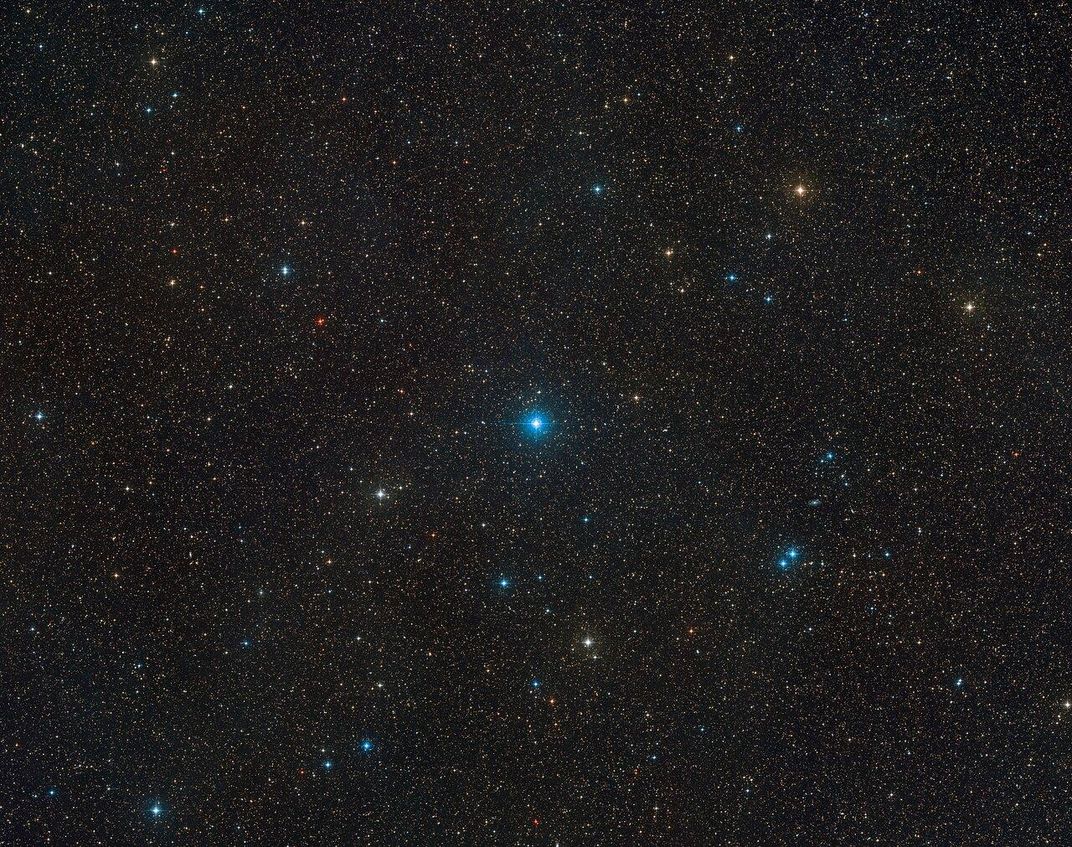Astronomers Discover the Closest Known Black Hole
The newfound ‘invisible’ object is only 1,000 light years from home
:focal(3095x1452:3096x1453)/https://tf-cmsv2-smithsonianmag-media.s3.amazonaws.com/filer/f7/b9/f7b9ec5e-3f93-445e-ab71-8994dfb5c21d/eso2007a.jpg)
The pair of stars in a system called HR 6819 is so close to us that on a clear night in the Southern Hemisphere, a person might be able to spot them without a telescope. What that stargazer wouldn’t see, though, is the black hole hiding right there in the constellation Telescopium. At just 1,000 light-years away, it is the closest black hole to Earth ever discovered, and it could help scientists find the rest of the Milky Way's missing black holes.
Dietrich Baade, an emeritus astronomer at the European Southern Observatory (ESO) in Germany and co-author of the study in Astronomy & Astrophysics, says the team never set out to find a black hole. They thought the HR 6819 system was a simple binary, made up of two visible stars orbiting each other. But their observations with the MPG/ESO 2.2-meter telescope at ESO’s La Silla Observatory in Chile revealed something stranger: One of the stars orbited an unknown object every 40 days, while the second star revolved around this inner pair.
The astronomers' new analysis, led by ESO scientist Thomas Rivinius, shows that the unseen object is more than four times the mass of our sun. An object so big yet invisible must be a black hole.
"This is a very exciting and significant result, and hopefully the first of many as people now start to go looking for more systems," says Sera Markoff, an astronomer at the University of Amsterdam who wasn't involved in the study. "If their measurements are accurate,” Markoff adds, the amount of missing mass for this unseen object “leaves no doubt that it is a black hole."
The Many Missing Black Holes
Most black holes are not truly black. Most, like those that have been detected in our galaxy, emit x-ray radiation that gives away their presence. "If matter falls into a black hole, it gets heated enormously, and then when the matter is very hot it radiates at very short wavelengths, in x-rays," Baade says.
In contrast, the newfound black hole is not gathering mass from its companion star. Very few examples of this type of “non-interacting” black hole are known in the Milky Way, but this discovery could lead astronomers to reveal a hidden cosmic population. Astronomers have predicted that in our galaxy alone there should be 100 million to 1 billion black holes of stellar mass (meaning black holes that formed when stars collapsed under the influence of their own gravity). But so far they've only detected about two dozen of them. "That's one of the biggest discrepancies in astronomy," Baade says. "Whether the kind of system we have found can fill the gap, we don't know, it's still too early to say, but it's an important step forward."

Astronomer Todd Thompson of Ohio State University, who was not involved in the study, adds: "Most of the information we have on black holes comes from interacting binary systems… There is an effort underway in the community to discover the very large population of non-interacting black hole-stellar binary systems that must exist in the Milky Way. This has the potential to refigure our understanding of the black hole population, and thus inform our understanding of how massive stars die."
Understanding these systems could affect the study of gravitational waves, ripples in the fabric of space-time predicted by Albert Einstein and finally detected in the past few years. Astronomers think one of the events that could create gravitational waves is the merger of two black holes that orbit each other, Baade says, and this process could accelerate if the black holes were in a triple system with another object.
"Such systems are not known nearby," Baade says. And while HR 6819 is not expected to develop a second black hole, this system is "closest in structure to what some people suspect are the progenitors of some gravitational waves."
Too Strange To Be True?
Some astronomers, like Hugues Sana of KU Leuven in Belgium, are excited by the findings but waiting to see the full accounting of the research methods. Last November, a report in Nature described a system known as LB-1 containing a star and a hidden “monster” black hole 70 times the mass of the sun. That size is far bigger than any black hole observed before and much bigger than theorists thought was possible. However, several teams of researchers, including Sana and his colleagues, have since pointed out flaws in the analysis.
The mass estimate for the hidden black hole relied on the mass-calibration for a standard "B-type" star, Sana says, but further research showed that the B-type star may be a stripped star, or a star that has lost its envelope because of mass transfer in a binary system, "and that makes it anything but normal. That has proven to be the downfall of the LB1 case and makes me wonder whether the same problem may affect the authors results on HR6819," Sana says.
Baade, however, says that he and his colleagues "have done a careful analysis and this analysis doesn't suggest there is anything special about the companion star." In fact, the ESO team thinks HR 6819 could help reveal the true nature of LB-1, which may also be a triple system, said co-author Marianne Heida, a postdoctoral fellow at ESO, in a statement.
"LB-1 is a bit further away from Earth but still pretty close in astronomical terms, so that means that probably many more of these systems exist," Heida said. "By finding and studying them we can learn a lot about the formation and evolution of those rare stars that begin their lives with more than about eight times the mass of the Sun and end them in a supernova explosion that leaves behind a black hole."